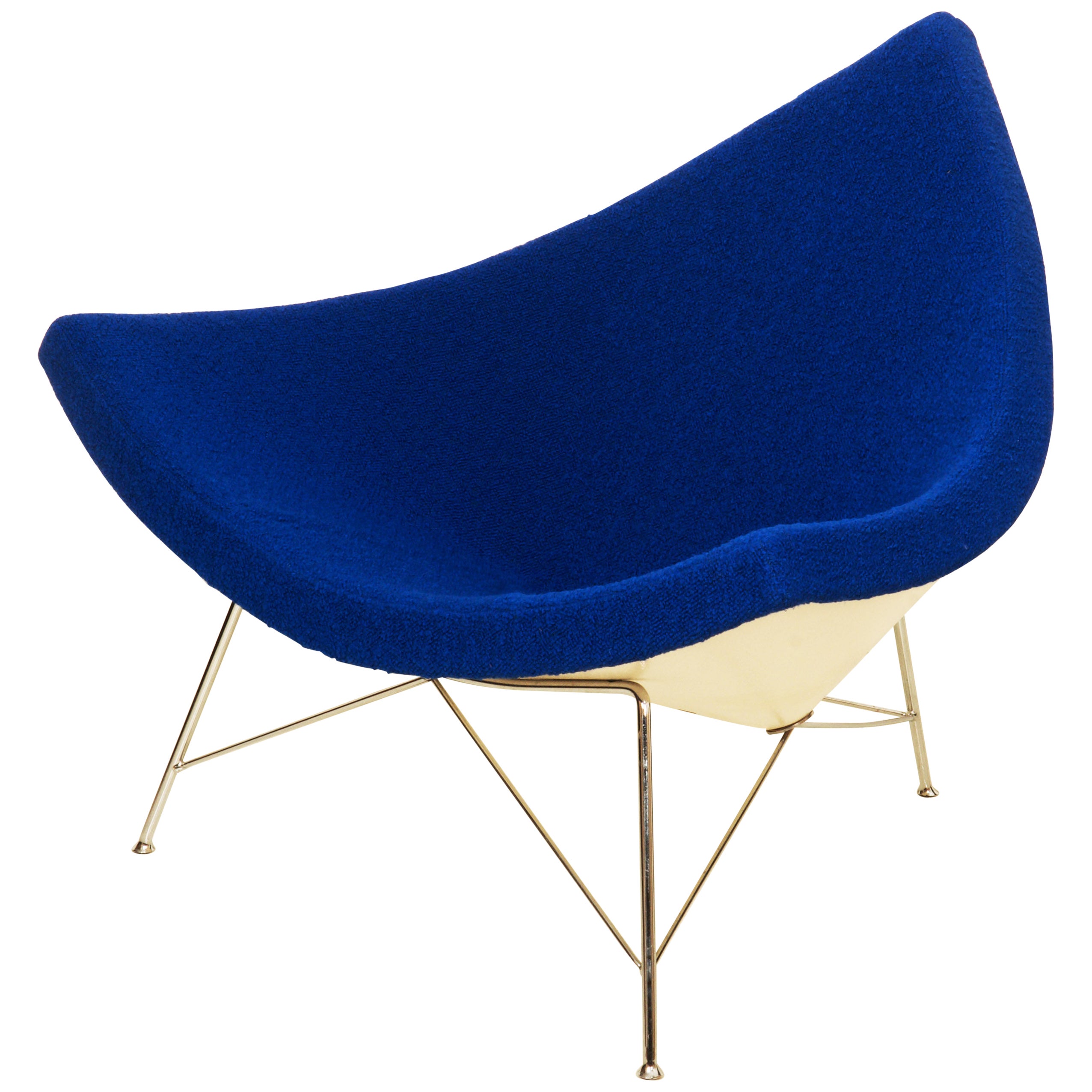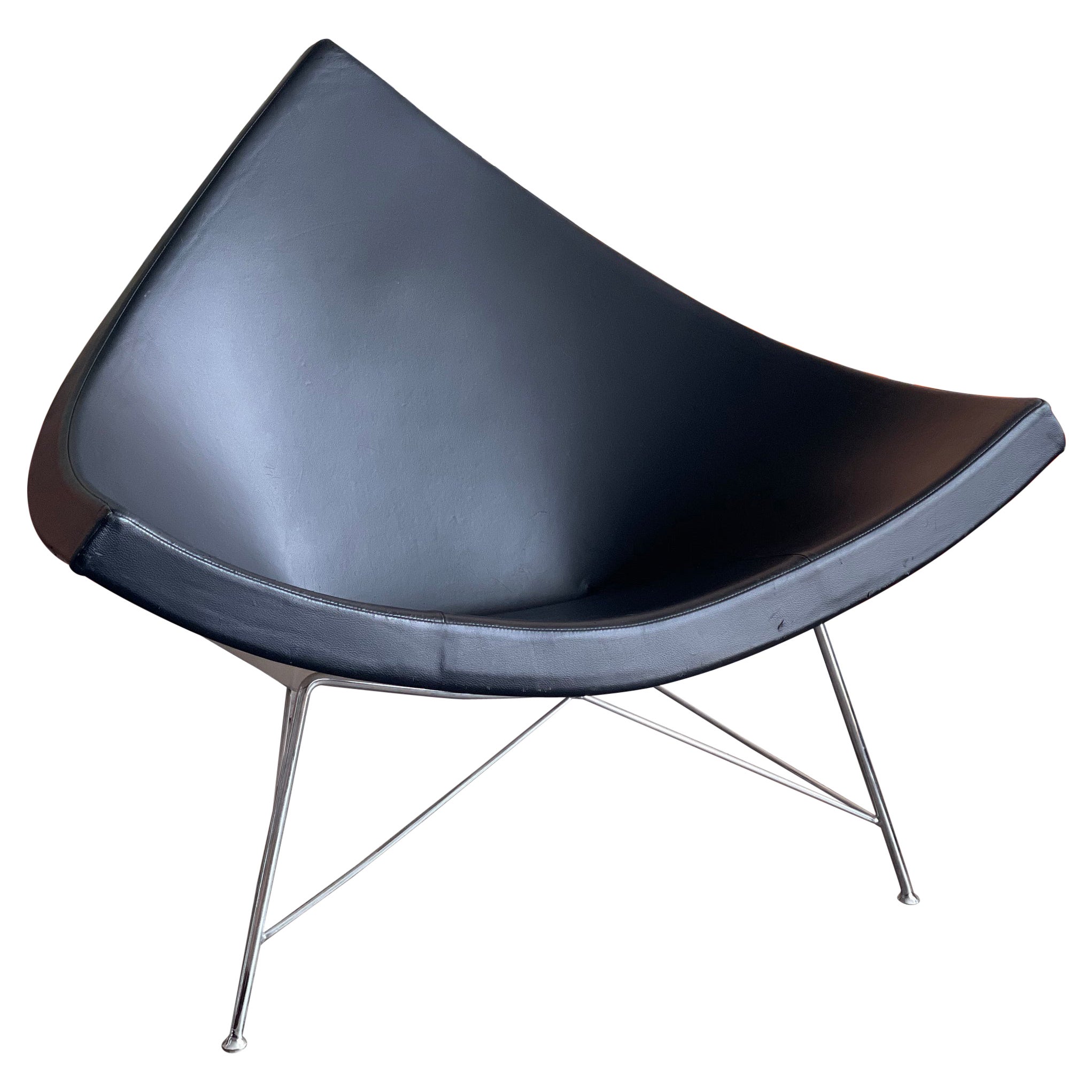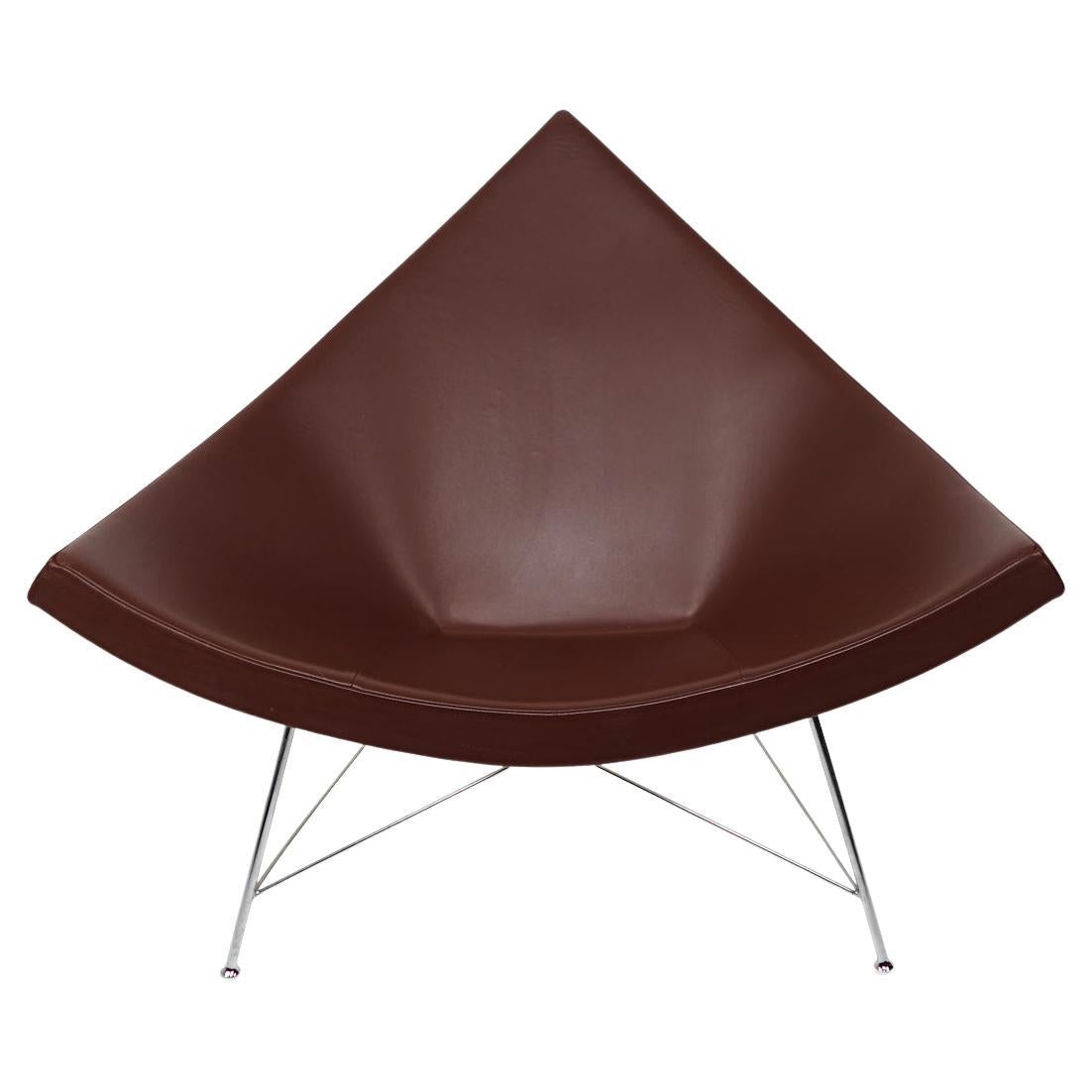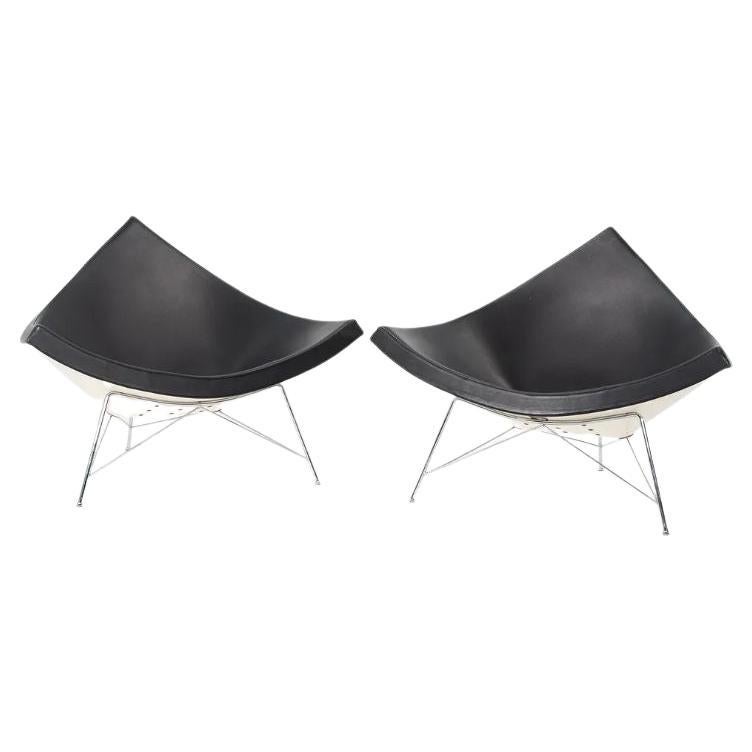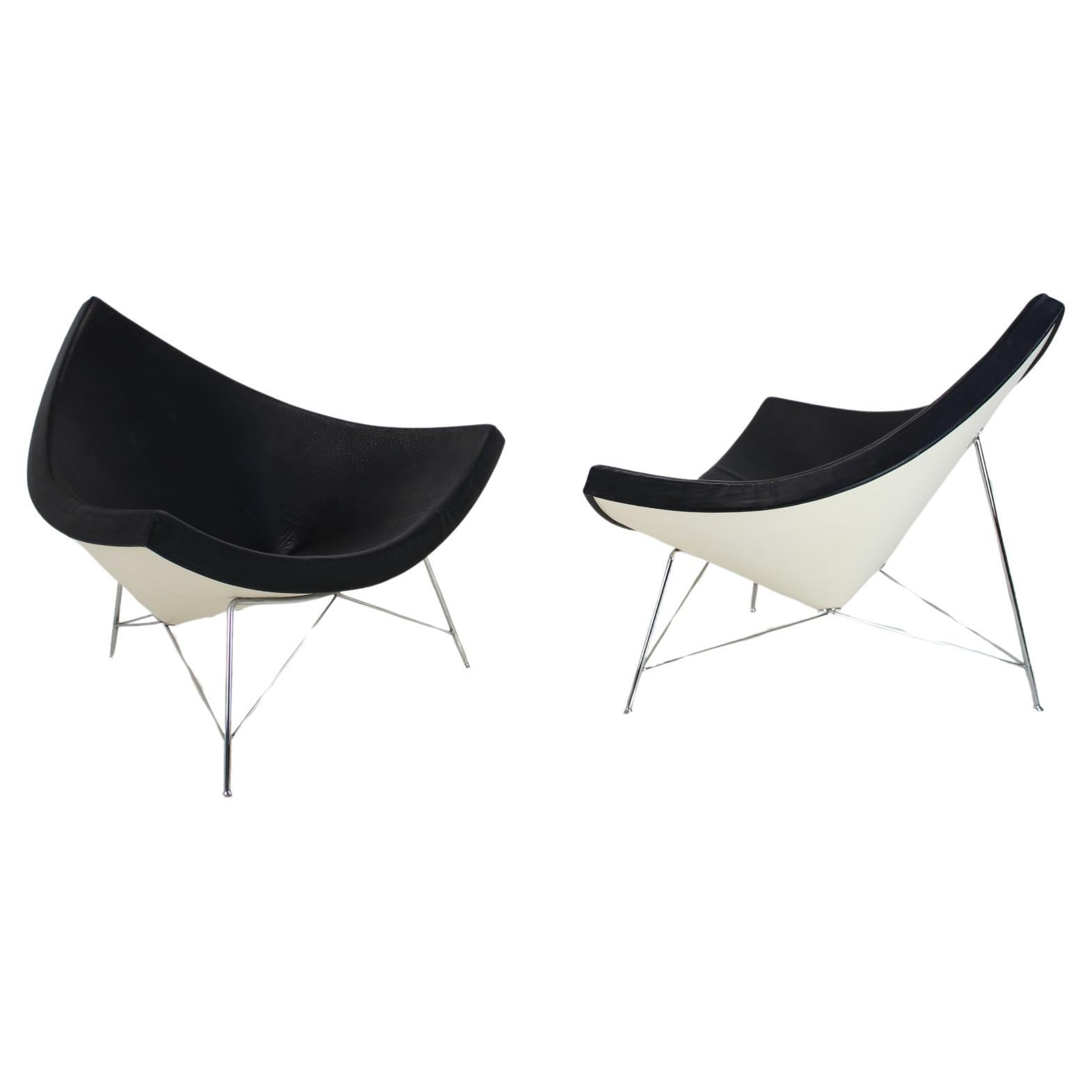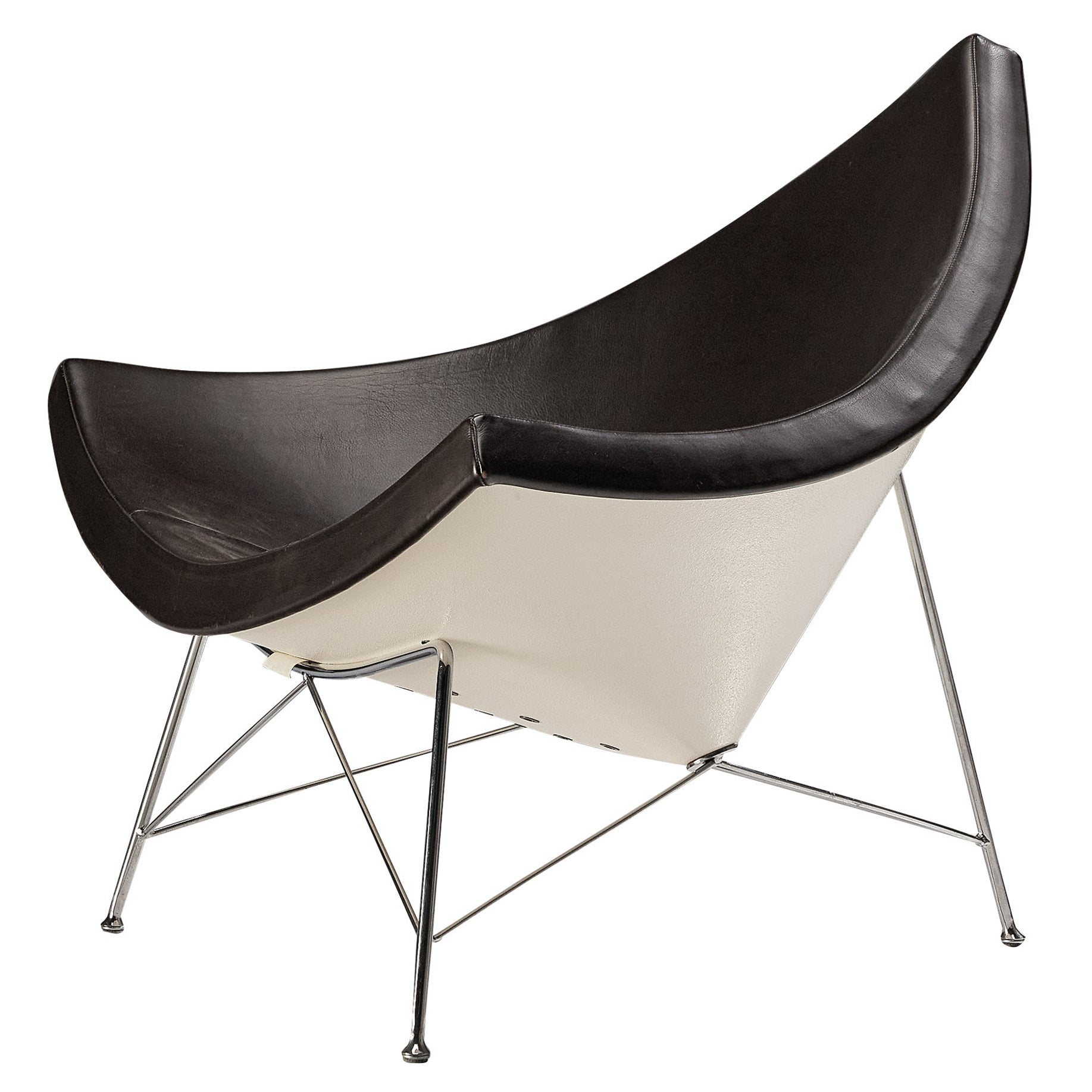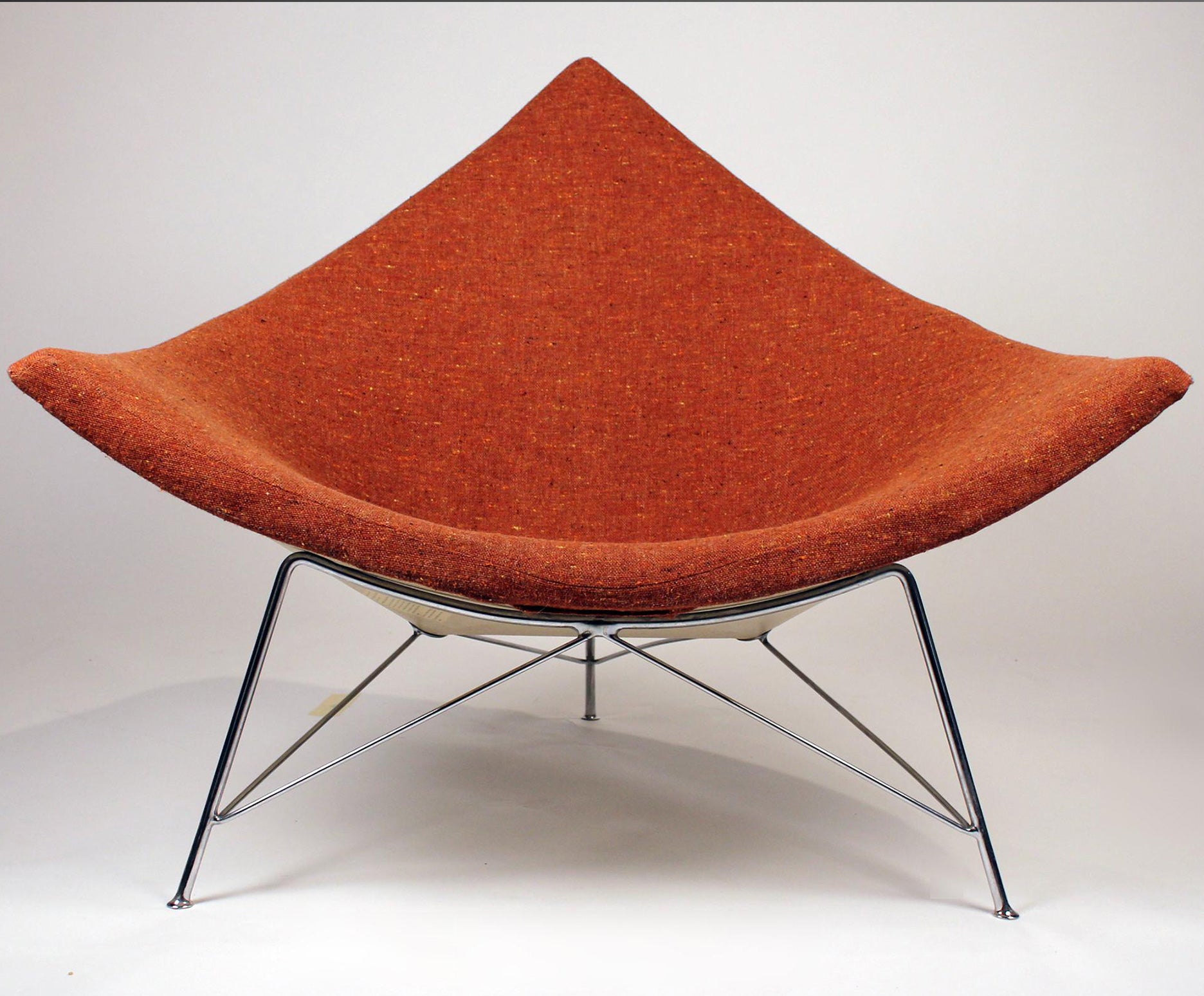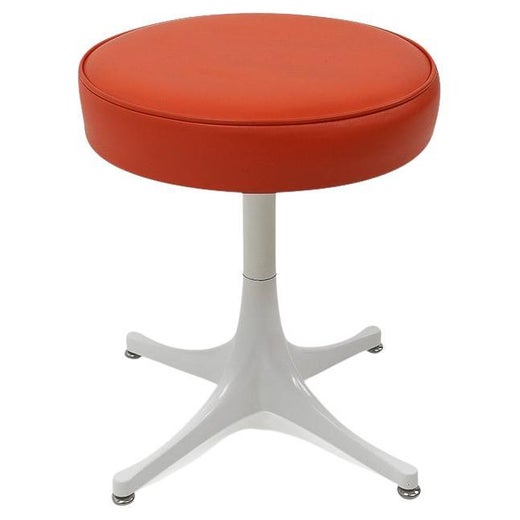Coconut Chair by George Nelson for Vitra, 1950s
About the Item
- Creator:Vitra (Manufacturer),George Nelson (Designer)
- Design:
- Dimensions:Height: 33.08 in (84 cm)Width: 40.95 in (104 cm)Depth: 32.68 in (83 cm)Seat Height: 10.63 in (27 cm)
- Style:Mid-Century Modern (Of the Period)
- Materials and Techniques:
- Place of Origin:
- Period:
- Date of Manufacture:circa 2000
- Condition:Wear consistent with age and use.
- Seller Location:Antwerp, BE
- Reference Number:
Coconut Lounge Chair
George Nelson (1908–86) attributed many of his design breakthroughs to creative “zaps.” He described such moments as “when the solitary individual finds he is connected with a reality he never dreamed of.” The Coconut lounge chair can certainly be traced back to one such “zap.”
The inspiration for the piece — which evolved from an idea presented by George Mulhauser, a designer who worked at Nelson’s Manhattan studio, George Nelson Associates, Inc., and is now credited with the concept — was as simple as the name suggests: a curved slice of coconut. In addition to the tropical fruit, the sleek chair nods to architect Eero Saarinen’s swerving Kresge Auditorium at the Massachusetts Institute of Technology, built in 1953.
Minimal in appearance, the Coconut lounge chair comprises only a few materials: a molded plastic shell, a single leather cushion and a trio of chrome legs. The chair was created in 1955 for Herman Miller, where Nelson served as director of design until 1972. In his studio, Nelson and his designers produced a wealth of hits, including benches, pendant lights and more for Herman Miller and other clients. In his director role, Nelson also supervised a team of now-legendary mid-century modern designers, such as Charles and Ray Eames, Alexander Girard and others.
Herman Miller founder D.J. De Pree hired Nelson in 1945 after having read about a modular storage system that he conceived with architect Henry Wright — it was featured in a joint editorial project from Life and Architectural Forum. Nelson continued to operate his design studio while at Herman Miller, and today, several of the pieces designed at George Nelson Associates, Inc. are in the Museum of Modern Art’s permanent collection, including the Coconut lounge chair.
George Nelson
Architect, designer, and writer George Nelson was a central figure in the mid-century American modernist design movement; and his thoughts influenced not only the furniture we live with, but also how we live.
Nelson came to design via journalism and literature. Upon receiving his bachelor’s degree in architecture from Yale in 1931, he won the Prix de Rome fellowship, and spent his time in Europe writing magazine articles that helped bring stateside recognition to Ludwig Mies van der Rohe, Gio Ponti, Le Corbusier and other canonical modernist architects. In the 1940s, Nelson wrote texts that suggested such now-commonplace ideas as open-plan houses, storage walls and family rooms. D.J. De Pree, the owner of the furniture maker Herman Miller, was so impressed by Nelson that in 1944 — following the sudden death of Gilbert Rohde, who had introduced the firm to modern design in the 1930s — he invited Nelson to join the company as its design director.
There Nelson’s curatorial design talents came to the fore. To Herman Miller he brought such eminent creators as Charles and Ray Eames, Isamu Noguchi, and the textile and furniture designer Alexander Girard. Thanks to a clever contract, at the same time as he directed Herman Miller he formed a New York design company, George Nelson & Associates, that sold furniture designs to the Michigan firm, as well as its competitor, the Howard Miller Clock Company. Nelson’s New York team of designers (who were rarely individually credited) would create such iconic pieces as the Marshmallow sofa, the Coconut chair, the Ball clock, the Bubble lamp series and the many cabinets and beds that comprise the sleek Thin-Edge line.
For dedicated collectors, as well as for interior designers who look beyond “the look,” there is a “cool-factor” inherent to vintage pieces from George Nelson and others. Nelson was in on it from the start, and it’s valuable to have a piece that was there with him. But still, as is evident from the offerings from dealers on these pages, in any of the designs, in any iteration whose manufacture Nelson oversaw and encouraged, there are shining elements of lightness, elegance, sophistication — and a little bit of swagger. George Nelson felt confident in his ideas about design and didn’t mind letting the world know.
- ShippingRetrieving quote...Ships From: Antwerp, Belgium
- Return PolicyA return for this item may be initiated within 14 days of delivery.
- Ico Parisi Easy Chairs with Purple Upholstery, 1950sBy Ico ParisiLocated in Antwerp, BEItalian pair of armchairs, by Ico Parisi, purple fabric. Black metal legs which end on brass round feet. 1950s Italian chic lounge chairs which would fit well in an eclectic Hollyw...Category
Mid-20th Century Italian Mid-Century Modern Armchairs
MaterialsBrass, Steel
- 'Aeo' Chairs by Paolo Deganello with the Archizoom Group for Cassina, 1973By Cassina, Paolo DeganelloLocated in Antwerp, BEArchizoom group; Aeo chair; Paolo Deganello; Cassina; 1970's; Mid-Century Modern; Italian design; Design classics; Contemporary; 'Aeo' chairs, designed by Paolo Deganello in 1973 f...Category
Vintage 1970s Italian Mid-Century Modern Armchairs
MaterialsSteel
- Pierre Paulin 446 Pair of Rare Club Chairs for ArtifortBy Artifort, Pierre PaulinLocated in Antwerp, BEArtifort 446 lounge chairs designed by Pierre Paulin and manufactured in Holland, 1962. The chairs have been newly upholstered in off-white / light grey velvet. The chairs have solid steel legs, chrome-plated. This is an extremely rare and very collectible pair of chairs by Paulin. Pierre Paulin was most famous for his innovative designs during the 1960s when he worked for Artifort. His most famed...Category
Vintage 1960s European Mid-Century Modern Armchairs
MaterialsSteel
- Modernist Easy chairs by Elmar Berkovich, Netherlands, 1950sBy Elmar BerkovichLocated in Antwerp, BEMid-Century Modern, Elmar Berkovich, lounge chair, 1950, the Netherlands. This is a super rare pair of chairs, original upholstery, teak frame with stunning details Elmar Berkovi...Category
Vintage 1950s Dutch Mid-Century Modern Lounge Chairs
MaterialsUpholstery, Teak
- LC3 Armchair by Le Corbusier for Cassina, 1990sBy Le Corbusier, Pierre Jeanneret, Le Corbusier, Pierre Jeanneret, Charlotte Perriand Cassina, Cassina, Charlotte PerriandLocated in Antwerp, BELe Corbusier; Pierre Jeanneret; Charlotte Perriand; 1928; LC3; Armchair; France; Italy; Cassina; Bauhaus; Modernism; LC3 single armchair for Cassina. An iconic piece of modernist design, designed in 1928 by Le Corbusier, his cousin and colleague Pierre Jeanneret, and Charlotte Perriand. The chair is a symbol of timeless elegance and exceptional comfort, with a unique combination of high-quality materials and craftsmanship. Made of high-quality materials by Italian manufacturer Cassina in the 1990s, this LC3 armchair has a chrome-plated steel frame that gives it a sleek and contemporary look. The thick Italian black leather adds a touch of luxury to the design and offers superior durability, while the combination of foam and goose down in the side and seat cushions provides a comfortable seating experience. With its low seat and wide armrests, the LC3 armchair is the perfect place to relax after a long day. The chair's design is both functional and stylish, making it an ideal addition to any modern living space. In excellent condition and signed by its designers, the LC3 armchair is a collector's item that is sure to be treasured for years to come. Whether you are looking to add a touch of sophistication to your home or simply enjoy the ultimate in comfort, the LC3 single armchair by Le Corbusier for...Category
1990s Italian Bauhaus Armchairs
MaterialsChrome
- LC3 Armchair by Le Corbusier for Cassina, 1990sBy Le Corbusier, Pierre Jeanneret, Le Corbusier, Pierre Jeanneret, Charlotte Perriand Cassina, Cassina, Charlotte PerriandLocated in Antwerp, BELe Corbusier; Pierre Jeanneret; Charlotte Perriand; 1928; LC3; Armchair; France; Italy; Cassina; Bauhaus; Modernism; LC3 single armchair for Cassina. An iconic piece of modernist design, designed in 1928 by Le Corbusier, his cousin and colleague Pierre Jeanneret, and Charlotte Perriand. The chair is a symbol of timeless elegance and exceptional comfort, with a unique combination of high-quality materials and craftsmanship. Made of high-quality materials by Italian manufacturer Cassina in the 1990s, this LC3 armchair has a chrome-plated steel frame that gives it a sleek and contemporary look. The thick Italian white leather adds a touch of luxury to the design and offers superior durability, while the combination of foam and goose down in the side and seat cushions provides a comfortable seating experience. With its low seat and wide armrests, the LC3 armchair is the perfect place to relax after a long day. The chair's design is both functional and stylish, making it an ideal addition to any modern living space. In excellent condition and signed by its designers, the LC3 armchair is a collector's item that is sure to be treasured for years to come. Whether you are looking to add a touch of sophistication to your home or simply enjoy the ultimate in comfort, the LC3 single armchair by Le Corbusier for...Category
1990s Italian Bauhaus Armchairs
MaterialsChrome
- George Nelson Coconut Armchair for VitraBy Vitra, George NelsonLocated in Vienna, ATThe armchair was designed by George Nelson for Vitra in 1955. The coconut chair is an icon of the design of the 1950s and is still a cult today. With clear shapes and reduced mate...Category
Early 2000s Swiss Mid-Century Modern Armchairs
MaterialsPlastic, Bouclé
- George Nelson "Coconut" Lounge Chair for VitraBy George NelsonLocated in Edmonton, ABThis iconic midcentury modern lounge chair was designed by George Nelson in 1956. This chair is a recent production.Category
Vintage 1950s American Mid-Century Modern Lounge Chairs
MaterialsSteel
- Mid-Century Modern Brown Leather Coconut Chair by George Nelson for VitraBy Vitra, George NelsonLocated in Doornspijk, NLThe Coconut chair was designed in 1955 by the American architect, industrial designer, author, editor and teacher George Nelson. Obviously he took his inspiration from a coconut that...Category
Vintage 1950s American Mid-Century Modern Lounge Chairs
MaterialsSteel
- 2007 Coconut Lounge Chair by George Nelson for Vitra in Black LeatherBy Vitra, George NelsonLocated in Philadelphia, PAThis is a single Coconut Lounge Chair, designed by George Nelson. This handsome lounge chair is composed of a molded reinforced plastic shell, with an upholstered black leather seat ...Category
Early 2000s American Modern Lounge Chairs
MaterialsLeather, Plastic
- Set of Two Leather Original George Nelson Coconut Chairs, VitraBy Vitra, George NelsonLocated in Praha, CZCoconut lounge chair designed by George Nelson for Herman Miller, manufactured by Vitra. Black leather, white shell and chrome legs, good original condition. - Marked by original lab...Category
Early 2000s German Mid-Century Modern Armchairs
MaterialsChrome
- Iconic George Nelson ‘Coconut’ Lounge ChairBy Vitra, George NelsonLocated in Waalwijk, NLGeorge Nelson, ‘Coconut’ lounge chair, fiberglass, leather upholstery, steel, United States, design 1955, later production The ‘Coconut’ lounge chair is one of George Nelson’s iconi...Category
Vintage 1950s American Mid-Century Modern Lounge Chairs
MaterialsSteel
Recently Viewed
View AllRead More
A Guide to Herman Miller’s Most Iconic Furniture
The prolific manufacturer has partnered with many of the world’s top designers since opening its doors in 1923. Here are some of the company’s greatest hits, which helped transform the American home and office.
Is Lionel Jadot the Willy Wonka of Upcycled Belgian Design?
From his massive collaborative workshop in a former paper factory, the designer concocts funky furniture from disused materials, as well as luxe hotel interiors like the new Mix Brussels.
